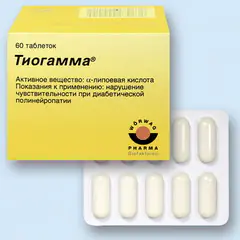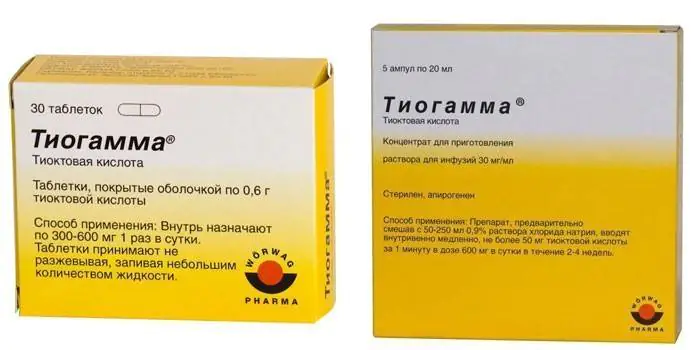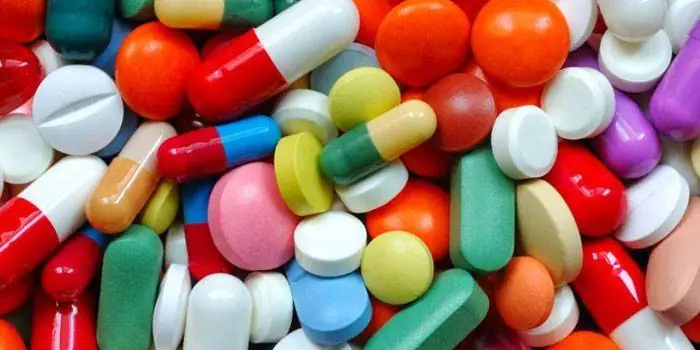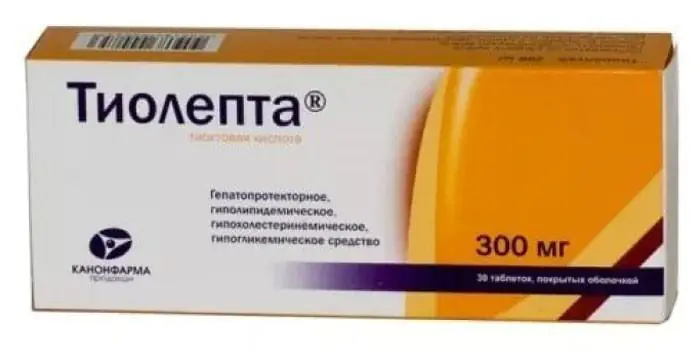Thiogamma: instructions for use and reviews
Latin name: Thiogamma
ATX code: A16AX01
Active ingredient: Thioctic acid
Manufacturer: Verwag Pharma GmbH and Co. KG (Worwag Pharma GmbH & Co. KG), Böblingen, Germany
Update of description and photo: 05/02/2018
Prices in pharmacies: from 186 rubles.

Thiogamma is a drug that regulates lipid and carbohydrate metabolism.
Release form and composition
- solution for infusion: transparent, light yellow or yellowish-green (50 ml in a dark glass bottle, 1 or 10 bottles in a cardboard box);
- concentrate for the preparation of a solution for infusion: a transparent yellowish-green solution (20 ml in a dark glass ampoule, 5 ampoules in a tray, 1, 2 or 4 trays in a cardboard box);
- film-coated tablets: oblong, convex on both sides, light yellow in color with white and yellow inclusions of varying intensity, with marks on both sides; a cross-section shows a light yellow core (10 pieces in a blister, 3, 6 or 10 blisters in a cardboard box).
Active substance – thioctic acid:
- 1 ml of solution – 12 mg (600 mg in 1 bottle);
- 1 ml of concentrate – 30 mg (600 mg in 1 ampoule);
- 1 tablet – 600 mg.
- solution: macrogol 300, meglumine, water for injection;
- concentrate: macrogol 300, meglumine, water for injection;
- tablets: colloidal silicon dioxide, croscarmellose sodium, microcrystalline cellulose, simethicone (dimethicone and colloidal silicon dioxide in a ratio of 94:6), lactose monohydrate, talc, magnesium stearate, hypromellose; shell composition: hypromellose, sodium lauryl sulfate, talc, macrogol 6000.
Pharmacological properties
Pharmacodynamics
The active ingredient of the drug is thioctic (alpha-lipoic) acid. It is an endogenous antioxidant that binds free radicals. Thioctic acid is formed in the body during the oxidative decarboxylation of alpha-keto acids. It is a coenzyme of multienzyme complexes in mitochondria and is involved in the oxidative decarboxylation of alpha-keto acids and pyruvic acid.
Alpha lipoic acid helps reduce blood glucose levels, increase glycogen concentrations in the liver and overcome insulin resistance. According to the mechanism of action, it is close to B vitamins.
Thioctic acid regulates carbohydrate and lipid metabolism, improves liver function and stimulates cholesterol metabolism. It has hypolipidemic, hypoglycemic, hepatoprotective and hypocholesterolemic effects. Helps improve neuron nutrition.
When using the megluminic salt of alpha-lipoic acid (has a neutral reaction) in solutions for intravenous administration, the severity of side effects can be reduced.
Pharmacokinetics
When administered orally, thioctic acid is quickly and completely absorbed from the gastrointestinal tract. When taken simultaneously with food, absorption of the drug is reduced. Bioavailability is 30%. To achieve the maximum concentration of the active substance, it takes from 40 to 60 minutes.
Thioctic acid undergoes a first-pass effect through the liver. Metabolized in two ways: by conjugation and by oxidation of the side chain.
The volume of distribution is approximately 450 ml/kg. Up to 80–90% of the dose taken is excreted by the kidneys in the form of metabolites and unchanged. The half-life ranges from 20 to 50 minutes. The total plasma clearance of the drug is 10–15 ml/min.
The time to reach maximum plasma concentration with intravenous administration of Thiogamma is 10–11 minutes, and the maximum plasma concentration is 25–38 mcg/ml. AUC (area under the concentration-time curve) is approximately 5 mcg/h/ml.
Indications for use
Thiogamma is a drug intended for the treatment of polyneuropathy (diabetic and alcoholic).
Contraindications
- hereditary galactose intolerance, lactase deficiency or glucose-galactose malabsorption (for tablets);
- age under 18 years;
- pregnancy;
- breastfeeding period;
- hypersensitivity to the components of the drug.
Instructions for use of Thiogamma: method and dosage
Solution for infusion and concentrate for the preparation of solution for infusion
The solution, including those prepared from concentrate, is administered intravenously.
The daily dose of Thiogamma is 600 mg (1 bottle of solution or 1 ampoule of concentrate).
The drug is administered over 30 minutes (at a rate of about 1.7 ml per minute).
Preparation of a solution from the concentrate: mix the contents of 1 ampoule with 50–250 ml of 0.9% sodium chloride solution. Immediately after preparation, the solution should be immediately covered with the included light-protective case. Store for no more than 6 hours.
When using the prepared solution, remove the bottle from the cardboard packaging and immediately cover it with a light-protective case. The infusion should be carried out directly from the vial.
The duration of treatment is 2–4 weeks. If it is necessary to continue therapy, the patient is transferred to the tablet form of the drug.
Film-coated tablets
The tablets should be taken orally on an empty stomach: swallowed whole and washed down with sufficient liquid.
The recommended dose of Thiogamma is 600 mg (1 tablet) per day.
The duration of treatment, depending on the severity of the disease, is 30–60 days.
If necessary, repeated courses can be conducted 2-3 times a year.
Side effects
Solution and concentrate
Thiogamma is generally well tolerated. Rarely, including isolated cases, the following side effects occur:
- from the endocrine system: decreased concentration of glucose in the blood (visual disturbances, increased sweating, dizziness, headache);
- from the central nervous system: disturbance or change in taste sensations, convulsions, epileptic seizure;
- from the hematopoietic system: hemorrhagic rash (purpura), thrombocytopenia, thrombophlebitis, pinpoint hemorrhages in the skin and mucous membranes;
- from the skin and subcutaneous tissue: eczema, itching, rash;
- from the organ of vision: diplopia;
- allergic reactions: urticaria, systemic reactions (discomfort, nausea, itching) up to the development of anaphylactic shock;
- local reactions: hyperemia, irritation, swelling;
- other: in case of rapid administration of the drug - difficulty breathing, increased intracranial pressure (a feeling of heaviness in the head occurs).
Film-coated tablets
Thiogamma is generally well tolerated. Rarely, including isolated cases, the following side effects occur:
- allergic reactions: urticaria, skin rash, itching, systemic reactions up to the development of anaphylactic shock;
- from the digestive system: abdominal pain, nausea, diarrhea, vomiting;
- from the endocrine system: decreased concentration of glucose in the blood (visual disturbances, increased sweating, dizziness, headache).
Overdose
An overdose of thioctic acid causes the following symptoms: headache, nausea and vomiting. When taking 10–40 g of Thiogamma in combination with alcohol, cases of severe intoxication, even death, have been reported.
In case of an acute overdose of the drug, confusion or psychomotor agitation occurs, usually accompanied by lactic acidosis and generalized convulsions. Cases of hemolysis, rhabdomyolysis, hypoglycemia, bone marrow suppression, disseminated intravascular coagulation, multiorgan failure and shock have been described.
Treatment is symptomatic. There is no specific antidote for thioctic acid.
special instructions
Patients with diabetes mellitus during treatment (and especially at the initial stage) need to monitor the concentration of glucose in the blood and, if necessary, adjust the dose of insulin or an oral hypoglycemic drug.
During treatment with Thiogamma, you should not drink alcoholic beverages, since ethanol reduces the therapeutic effect of thioctic acid and promotes the development and progression of neuropathy.
Each tablet contains 49 mg of lactose monohydrate, which corresponds to at least 0.0041 bread units.
Thioctic acid does not affect the ability to operate potentially dangerous machinery or drive a car.
Use during pregnancy and lactation
The drug is prohibited for use in pregnant and lactating women.
Use in childhood
According to the instructions, Tiogamma is contraindicated for children and adolescents under 18 years of age.
Drug interactions
- ethanol and its metabolites: the effect of thioctic acid is weakened;
- cisplatin: its effectiveness decreases;
- glucocorticosteroids: their anti-inflammatory effect is enhanced;
- insulin, oral hypoglycemic drugs: their effect is enhanced.
Thioctic acid binds metals (iron, magnesium), therefore, if simultaneous use of drugs containing them is necessary, at least 2-hour intervals between doses should be observed.
Thioctic acid reacts with sugar molecules [for example, with a solution of levulose (fructose)], resulting in the formation of sparingly soluble complexes.
In the form of an infusion solution, Thiogamma is incompatible with solutions that react with disulfide and SH groups, Ringer's solution and dextrose solution.
Analogs
Analogues of Thiogamma are the following drugs: Thioctacid BV, Lipoic acid, Thiolepta, Berlition 300, Thioctacid 600T.
Terms and conditions of storage
Store out of reach of children, protected from light, at temperatures up to 25 °C.
Shelf life – 5 years.
Conditions for dispensing from pharmacies
Dispensed by prescription.
Reviews about Tiogamma
The drug is quite often prescribed to patients with diabetes mellitus and a predisposition to polyneuropathy, since it is a good prophylactic agent for diseases of the peripheral nervous system.
Reviews of Thiogamma note that with a relatively short course of treatment, the severe consequences of endocrine diseases can be prevented. The advantage of using the drug is the very rare development of possible side effects.
Experts also speak positively about Thiogamma, noting its therapeutic properties, the rare development of side effects and the low likelihood of overdose.
Allergic skin reactions that may occur during treatment are most often observed in patients with a predisposition. To avoid such reactions, it is recommended to conduct an allergy test before using the drug.
Price for Tiogamma in pharmacies
Prices for Tiogamma in pharmacies:
- film-coated tablets, 600 mg (30 pieces per package) – from 894 rubles;
- film-coated tablets, 600 mg (60 pieces per package) – from 1835 rubles;
- solution for infusion (50 ml bottle, 1 pc.) – from 211 rubles;
- solution for infusion (50 ml bottle, 10 pcs.) – from 1,784 rubles.
- concentrate for preparing a solution for infusion (20 ml ampoules, 10 pcs.) – from 1800 rubles.
Various medications can be used to regulate metabolism and treat neuropathy. Doctors often prescribe the drug Thiogamma, which contains thioctic (lipoic, alpha-lipoic) acid, which has properties similar to B vitamins. Reading the instructions for use of the drug will help you obtain information about the indications, side effects, and method of taking the medicine.
Instructions for use of Thiogamma
Thiogamma tablets are drugs that regulate the metabolism of carbohydrates and lipids in the body. This effect is achieved due to the content of lipoic acid. It is one of the substances produced by the body, but if it is deficient, metabolism slows down and problems begin in the form of obesity and diabetes. Medicines based on thioctic acid will help in the treatment of these pathologies and polyneuropathy.
Composition and release form
The drug Thiogamma is available in the form of tablets, solution for infusion and concentrate for the preparation of solution for infusion. The tablets are covered with a light yellow shell, having yellow and white inclusions of different saturations, the shape is oblong and biconvex, there are marks on both sides, and a light yellow tablet core is visible on the cross section. Solution for infusion is yellow-green or light yellow, transparent. The concentrate is a transparent yellow or green-yellow solution in glass ampoules. Composition of the drug:
Thioctic acid 600 mg
Hypromellose, colloidal silicon dioxide, microcrystalline cellulose, lactose monohydrate, carmellose sodium, talc, simethicone, magnesium stearate, macrogol 6000, sodium lauryl sulfate
Meglumine thioctate (equivalent to 600 mg thioctic acid)
Macrogol 300, meglumine, water
Pharmacodynamics and pharmacokinetics
The active ingredient of the drug is thioctic acid, which belongs to the category of endogenous antioxidants that bind free radicals. Inside the human body, it appears in the process of oxidative decarboxylation of alpha-keto acids. The medication has a metabolic and antioxidant effect, lowers blood sugar levels, increases glycogen reserves in the liver and reduces insulin resistance.
Taking Thiogamma affects carbohydrate and lipid metabolism, stimulates liver function and blood circulation, affects cholesterol metabolism, and removes toxins in case of poisoning with heavy metal salts. The medication combines hypoglycemic and hypocholesterolemic effects, is a hepatoprotector, and optimizes neuronal trophism. Taking thioctic acid reduces the level of glycation products, stimulates endoneurial blood flow, increases glutathione levels, providing improvement in the condition of peripheral nerve fibers in diabetic polyneuropathy.
The medication is completely absorbed in the gastrointestinal tract in a short period. Taking it with food reduces its absorption. Metabolism of Thiogamma occurs in the liver through side chain oxidation followed by conjugation. The drug is excreted mainly by the kidneys (up to 90%). The half-life of the substance is about 25 minutes. A minimal amount of the drug components may be found unchanged in the urine.

Indications for use
Thiogamma has indications for use due to the properties of the active substance of the drug. The main reasons for prescribing the drug:
- neuropathy due to diabetes;
- painful conditions of the liver: fatty degeneration processes of hepatocytes, cirrhosis and hepatitis of various origins;
- destruction of nerve trunks caused by alcohol;
- poisoning with severe symptoms (mushrooms, heavy metal salts);
- sensorimotor or peripheral polyneuropathy.
Directions for use and dosage
Depending on the form of the drug, the method of administration and dosage differ. It is especially important to follow the rules when using the solution and concentrate to prepare the solution. After removing the bottle from the box, it is necessary to immediately cover it with the included light-protective case (light has a destructive effect on thioctic acid). A solution is prepared from the concentrate: the contents of one ampoule are mixed with 50-250 ml of 0.9% sodium chloride solution. It is recommended to administer the drug immediately, the maximum storage period is 6 hours.
Thiogamma tablets
The tablets are taken once a day before meals at the dosage prescribed by the doctor; the tablets are not chewed and washed down with a small amount of liquid. The duration of the course of therapy is 30-60 days and depends on the severity of the disease. It is permissible to repeat the course of therapy two to three times during the year.
Thiogamma for IVs
When using the drug, it is important to remember to use a light-protective case after removing the bottle from the box. The infusion must be carried out at an injection rate of 1.7 ml per minute. When administered intravenously, it is necessary to maintain a slow pace (period of 30 minutes), a dosage of 600 mg per day. The course of treatment is two to four weeks, after which it is possible to continue taking the drug in oral tablet form at the same daily dosage of 600 mg.
For facial skin
The drug Thiogamma has found its application for facial care. For this purpose, the contents of dropper bottles are used. The use of this form is due to the optimal concentration of the drug. The drug in ampoules is not suitable due to the high density of the active substance, this can cause an allergic reaction. The solution from the bottles must be applied twice a day - morning and evening. Before use, you need to wash your face with warm water (possibly with lotion) to soften the pores and deep penetration of the active ingredient.

special instructions
Among the sections of the instructions for use, the section on special instructions deserves close study. It contains rules and recommendations for using the drug:
- The medication is prohibited for use by patients with fructose intolerance, glucose-galactose malabsorption syndrome, and glucose-isomaltase deficiency.
- In case of diabetes mellitus, at the beginning of therapy, blood glucose levels should be carefully monitored; sometimes dose adjustment of insulin and other hypoglycemic agents is required. One tablet contains less than 0.0041 bread units.
- During treatment you should refrain from drinking alcohol. This reduces the therapeutic effect and may cause progression of neuropathy.
- During treatment, you can operate dangerous machinery and vehicles. The drug does not impair concentration and clarity of vision.
During pregnancy
Due to the content of active substances, the use of Thiogamma during pregnancy and lactation is prohibited. This is associated with a high risk of disruption of the vital functions of the fetus and the development of the infant or newborn. If it is impossible to stop using the drug during lactation, then it is necessary to stop or stop breastfeeding to avoid harm to the baby.
In childhood
The drug is prohibited for use by people under 18 years of age. This is due to the increased effect of thioctic acid on metabolism, which can lead to uncontrollable consequences in the body in children and adolescents. Before use, you should definitely consult a doctor and obtain permission after a thorough examination of your organs and systems.
Thiogamma for weight loss
Lipoic acid is an antioxidant, accelerates metabolic processes, improves the functioning of the pancreas, so it can be used for weight loss. It regulates sugar levels, slows down the aging process, improves blood flow, accelerates the process of converting carbohydrates into energy, and promotes the oxidation of fatty acids. The acid also blocks an enzyme in brain cells that is responsible for sending hunger signals, which helps control appetite.
As we age, the production of lipoic acid slows down, so it is used as a continuous supplement. The drug Tiogamma can be used for weight loss, but subject to regular physical activity. Nutritionists advise taking 600 mg of the active ingredient/day before or after breakfast, along with carbohydrates, after training or with the last meal. At the same time as taking it, you should reduce the caloric content of food consumed.
Drug interactions
Thioctic acid in Thiogamma enhances the anti-inflammatory effect of glucocorticosteroids. Other examples of drug interactions:
- The drug reduces the effectiveness of Cisplatin.
- The active substance binds metals, so the simultaneous use of iron, calcium and magnesium supplements is prohibited - at least two hours must pass between the use of these drugs.
- The medication enhances the effect of insulin and oral hypoglycemic agents.
- Ethanol and metabolites weaken the effect of the acid.

Side effects
While taking Thiogamma, various side effects may occur. The most common ones include:
- nausea, diarrhea, vomiting, stomach pain, hepatitis, gastritis;
- intracranial hemorrhage;
- respiratory disorders, shortness of breath;
- allergic reactions, anaphylactic shock, skin rash, itching, urticaria;
- disturbance of taste sensations;
- decreased concentration of glucose in the blood - hypoglycemia: dizziness, headache, increased sweating, blurred vision.
Overdose
Symptoms of an overdose of Thiogamma are headache, vomiting, nausea. Acute overdose is manifested by confusion, psychomotor agitation, generalized convulsions, and the formation of lactic acidosis. Sometimes shock, hemolysis, intravascular coagulation, and bone marrow suppression may occur. Taking 10-40 g of thioctic acid in combination with alcohol leads to multiple organ failure, intoxication, and death. There is no specific antidote; symptomatic therapy, analgesics, and injections are prescribed.
Contraindications
The drug is not prescribed during pregnancy, breastfeeding, children and adolescents under 18 years of age. Other contraindications for the use of the drug Tiogamma are:
- galactose intolerance;
- hepatitis, cirrhosis;
- epileptic seizures;
- lactase deficiency;
- glucose-galactose malabsorption;
- hypersensitivity to the components of the composition or thioctic acid.
Terms of sale and storage
You can buy the drug Thiogamma with a prescription; it should be stored in a dry place, inaccessible to children, at a temperature of up to 25 degrees for no more than five years.
Analogues of Thiogamma
Thiogamma substitutes include those drugs that contain the same active substance. Analogues of the drug:
- Lipoic acid is a tablet preparation, a direct analogue;
- Berlition – tablets and concentrated solution based on thioctic acid;
- Thiolepta - plates and solution for the treatment of diabetic, alcoholic neuropathy;
- Thioctacid turbo is a metabolic drug based on alpha-lipoic acid.

The cost of purchasing Thiogamma will depend on the chosen form of release of the drug, the amount of medicine in the package and the pricing policy of the retailer and manufacturer. Approximate prices for the product in Moscow:
Solution for infusion 150 ml
Tablets 600 mg, 30 pcs.
Tablets 600 mg, 60 pcs.
Solution for infusion 50 ml, 10 bottles
Reviews
Alla, 37 years old The drug Tiogamma was recommended to me by a friend who lost weight on it beyond recognition. She took it with the doctor’s permission, after training, and additionally restricted herself in nutrition. I started taking pills and eating right, and lost five kilograms in a month. Excellent result, I think I will repeat the course more than once.
Alexey, 42 years old Due to my addiction to alcohol, I developed polyneuropathy, my hands were shaking, and I began to suffer from frequent mood swings. Doctors said that we must first recover from alcoholism, and then eliminate the consequences. At the second stage of therapy, I began taking Thiogamma solution. It effectively copes with the problem of neuropathy, I began to sleep better.
Olga, 56 years old I suffer from diabetes, so I have a tendency to develop neuropathy. Doctors prescribed the drug Thiogamma for prevention, and additionally adjusted the insulin dose. I take the pills according to the instructions and see changes - I have become much calmer, I no longer have cramps at night and in the morning, my hands do not shake from anxiety.
Larisa, 33 years old I heard advice from a friend in cosmetology: use lipoic acid in ampoules to eliminate age spots and incipient wrinkles. I asked the doctor to write out a prescription and bought it and used it in the evenings: after washing my face, I applied the solution instead of tonic, and then the cream on top. Within a month, the spots began to disappear, the skin became noticeably fresher.
Read these instructions carefully before you start taking this medicine.
• Save the instructions; you may need them again.
• If you have any questions, consult your doctor.
• This medicine is for you personally and should not be given to others because it may harm them even if they have the same symptoms as you.
Registration number:
Name of the drug:
Trade name of the drug: Thiogamma ®
Generic name: thioctic acid
Dosage form:
film-coated tablets.
Compound:
1 film-coated tablet contains:
active substance: thioctic acid – 600 mg;
Excipients: hypromellose 25.00 mg, colloidal silicon dioxide 25.00 mg, microcrystalline cellulose 69.00 mg, lactose monohydrate 69.00 mg, croscarmellose sodium 16.00 mg, talc 36.366 mg, simethicone 3.636 mg (dimethicone and colloidal silicon dioxide 96: 6), magnesium stearate 16.00 mg: shell: macrogol 6000 - 0.60 mg, hypromellose 2.80 mg, talc 2.00 mg, sodium lauryl sulfate 0.025 mg.
Description:
oblong, biconvex film-coated tablets, with a smooth and slightly shiny surface, with one dividing line on both sides, yellow in color with possible inclusions of white and dark yellow.
Pharmacotherapeutic group:
ATX Code:
Pharmachologic effect:
Pharmacodynamics:
Thioctic acid is an endogenous antioxidant (binds free radicals).
In the body it is formed during the oxidative decarboxylation of alpha-keto acids.
As a coenzyme of mitochondrial multienzyme complexes, it participates in the oxidative decarboxylation of pyruvic acid and alpha-keto acids. Helps reduce blood glucose concentrations and increase glycogen in the liver, as well as reduce insulin resistance.
Participates in the regulation of lipid and carbohydrate metabolism, affects cholesterol metabolism, improves liver function, has a detoxification effect in cases of poisoning with heavy metal salts and other intoxications. It has hepatoprotective, hypolipidemic, hypocholesterolemic, hypoglycemic effects. Improves trophism of neurons.
In diabetes mellitus, thioctic acid reduces the formation of advanced glycation end products, improves endoneurial blood flow, increases glutathione content to physiological values, which ultimately leads to an improvement in the functional state of peripheral nerve fibers in diabetic polyneuropathy.
Pharmacokinetics:
When taken orally, it is quickly and completely absorbed from the gastrointestinal tract; simultaneous intake with food reduces absorption. Bioavailability – 30-60% due to the “first pass” effect through the liver. The time to reach the maximum concentration (6 μg/ml) is about 30 minutes. Metabolized in the liver by side chain oxidation and conjugation. Thioctic acid and its metabolites are excreted by the kidneys (80-90%), in small quantities - unchanged. Half-life 25 min.
Indications for use:
Diabetic polyneuropathy and alcoholic polyneuropathy.
Contraindications:
Hypersensitivity to thioctic acid or other components of the drug. Children under 18 years of age.
Hereditary galactose intolerance, lactase deficiency or glucose-galactose malabsorption.
Pregnancy and breastfeeding period. (See section “Use during pregnancy and breastfeeding”).
• Before taking the drug, be sure to consult your doctor.
Use during pregnancy and breastfeeding:
The use of Thiogamma ® during pregnancy and lactation is contraindicated. (See section "Contraindications").
Directions for use and dosage:
Prescribe 600 mg (1 tablet) of Thiogamma ® orally once a day. The tablets are taken on an empty stomach, without chewing, with a small amount of liquid.
The duration of treatment is 30-60 days, depending on the severity of the disease. The course of treatment can be repeated 2-3 times a year.
Side effect:
The frequency of adverse reactions is given in accordance with the WHO classification:
| Often | more than 1 in 10 treated |
| Often | less than 1 in 10 but more than 1 in 100 treated |
| On occasion | less than 1 in 100 but more than 1 in 1000 treated |
| Rarely | less than 1 in 1,000 but more than 1 in 10,000 treated |
| Very rarely | less than 1 in 10,000, including isolated cases |
| Not known | cannot be determined from the available data |
Very rare (Gastrointestinal (GIT) disorders:
nausea, vomiting, abdominal pain, diarrhea.
Immune system disorders:
allergic reactions (up to the development of anaphylactic shock), skin rash, urticaria, itching; autoimmune insulin syndrome (AIS), clinical manifestations of AIS can be: dizziness, sweating, muscle tremors, increased heart rate, nausea, headache, confusion, impaired visual perception, loss of consciousness, coma.
Nervous system disorders:
change or disturbance of taste sensations.
Metabolic and nutritional disorders:
due to improved glucose absorption, a decrease in blood glucose concentration is possible. In this case, symptoms of hypoglycemia may occur - dizziness, increased sweating, headache, visual disturbances.
Frequency unknown (cannot be determined from available data):
Skin and subcutaneous disorders:
eczema.
• If any of the side effects indicated in the instructions get worse, or you notice any other side effects not listed in the instructions, Tell your doctor about this.
Overdose:
Symptoms: nausea, vomiting, headache.
When taking doses of 10 to 40 g of thioctic acid in combination with alcohol, cases of intoxication, including death, were observed.
Symptoms of acute overdose: psychomotor agitation or confusion, usually followed by the development of generalized convulsions and the formation of lactic acidosis. Cases of hypoglycemia, shock, rhabdomyolysis, hemolysis, disseminated intravascular coagulation, bone marrow depression and multiorgan failure have also been described.
Treatment is symptomatic. There is no specific antidote.
Interaction with other drugs:
Thioctic acid enhances the anti-inflammatory effect of glucocorticosteroids. With the simultaneous administration of thioctic acid and cisplatin, a decrease in the effectiveness of cisplatin is observed.
Thioctic acid binds metals, so it should not be prescribed simultaneously with drugs containing metals (for example, iron, magnesium, calcium) - the interval between doses should be at least 2 hours.
With simultaneous use of thioctic acid and insulin or oral hypoglycemic drugs, their effect may be enhanced.
Ethanol and its metabolites weaken the effect of thioctic acid.
• If you are already taking other medications or are planning to take them, be sure to consult your doctor before taking Thiogamma ®.
special instructions
Patients with rare hereditary fructose intolerance, glucose-galactose malabsorption syndrome or glucose-isomaltose deficiency should not take Thiogamma ®.
In patients with diabetes mellitus, constant monitoring of blood glucose concentrations is necessary, especially at the initial stage of therapy.
In some cases, it is necessary to reduce the dose of insulin or oral hypoglycemic drug to avoid the development of hypoglycemia.
If hypoglycemia develops, you must immediately stop taking the drug Thiogamma ®.
If symptoms of hypersensitivity appear, you must immediately stop taking the drug Thiogamma ®.
Patients taking the drug Thiogamma ® should refrain from drinking alcohol. Alcohol consumption during therapy with Thiogamma ® reduces the therapeutic effect and is a risk factor contributing to the development and progression of neuropathy.
1 film-coated tablet of Thiogamma ® 600 mg contains less than 0.0041 bread units.
Cases of the development of autoimmune insulin syndrome (AIS) during treatment with thioctic acid have been described. The possibility of AIS is determined by the presence of the HLA-DRB1*04:06 and HLA-DRB1*04:03 alleles in patients.
Impact on the ability to drive vehicles and operate machinery:
Taking the drug Thiogamma ® does not affect the ability to drive vehicles or operate other mechanisms.
Release form:
Film-coated tablets 600 mg.
10 film-coated tablets in a blister made of PVC/PVDC/aluminum foil.
3, 6 or 10 blisters along with instructions for use in a cardboard box.
Storage conditions:
Store in a dry place, at a temperature not exceeding 25° C.
Keep out of the reach of children.
Best before date:
5 years. Do not use after the expiration date indicated on the package.
Vacation conditions:
Registration Certificate Holder
Verwag Pharma GmbH & Co. KG, Calver Strasse 7, 71034 Böblingen, Germany
Manufacturer
Dragenofarm Apotheker Püschl GmbH, Göllstrasse 1.84529 Tittmoning, Germany
Organization receiving consumer complaints:
Representative office of Verwag Pharma GmbH & Co. KG in Russia.
117587, Moscow, Varshavskoe highway, 125 Zh, bldg. 6.



